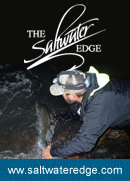by John Papciak
CYCLES
“They come and go in cycles, that’s just how it is.”
I hate that saying – a fisherman’s ready-made excuse for taking as many fish as possible. No need to think about conservation or restrictions. What the lord giveth, the lord will take away. And in due time, if we are patient, they will return.
As if synthetic materials for lines and nets, electronics, gas powered engines, and modern refrigeration and transportation played no part in being able to extract more fish, more quickly, and distribute them to a growing national and then global market.
But let’s save that debate for another day.
Today I’m thinking about cycles.
Miriam-Webster broadly defines a cycle as a set of regular or repeated actions or events. I admit to thinking of cycles when I consider fish and bait year classes.
We had the return of the sand eel a few years ago. Now we are up to our elbows in bunker. Peanuts were the main attraction this past fall. My first official year of surf casting was 1976, and you couldn’t go anywhere that summer without running into weakfish. Christ, for a brief period of time, I thought this was the norm – that you could catch weakfish on anything, anywhere. Then we had blowfish in the bays. And spot. In the winter you could go surf casting for whiting.
The weakfish left, but returned by the mid 90s. As of this writing they are once again a rarity.
Whiting left, never to return to our local waters.
You all know the saga on bass.
Anyway, this “cycle” word popped into my head as I read a Bloomberg news article the other day. The buzz was the impact that “The Child” (El Nino) might have on global weather and crops in 2016.
Need a visual? Think “Trading Places” – Frozen Concentrated Orange Juice.
As I scanned this and related stories, I was struck by the repeated use of the words “cycle” and “oscillation.”
El Niño ?
Maybe a quick refresher on El Niño.
Trade winds along the equator tend to blow east to west in the eastern Pacific. This pushes warm surface water away from the South American coast. Cooler water then comes up to the surface. Thats how it normally should work. During an El Niño cycle (2015-2016 is an official El Niño event), the prevailing trade wind decreases, or even reverses. The eastern Pacific stays warmer. And much of the heat is transferred into the atmosphere. A portion of that is shipped to the U.S., thanks to prevailing winds in the Northern Hemisphere. Southern states get the moisture, but in the Northeast we generally see warmer-than-average temperatures. Aside from other general increases in air and water temperatures (Global Warming), the mild temperatures we saw this past winter were most certainly helped by El Niño.
There is plenty of scientific literature on how El Nino impacts weather, and how this weather impacts the life cycles of specific plants and animals. But what about the impact of El Niño on specific migratory species of fish in the mid Atlantic? I’m sure we can all come up with a laundry list, but now we begin to dance between verified science and junk science.
So where am I going with this?
1. Unseasonable weather most certainly effects our local fisheries.
2. There is a meaningful – yet not fully understood – El Niño local weather impact.
3, El Nino happens at irregular but recurring intervals. Cycles.
So, as much as we hate to deal in things that we can’t comprehend, much less control, there is some truth in the saying that our fish “follow cycles.”
El Niño just so happens to be a very big and obvious cyclic event – so much so that early Peruvian sailors recognized it as such, generally observed in December, and so gave it the name of The Child.
The hidden message? We would be naive in thinking El Nino is the only naturally-occurring cycle to contend with when thinking about boom or bust bait or game fish.
So does that mean you might as well fillet and sell every fish you catch, Mother Nature will replenish it all when she’s good and ready?
That would sort of be like watering your lawn when the reservoir is running low. But at least then you can see exactly how much water remains. And officials are smart enough to enact emergency laws when they SEE it getting too low.
Getting back to the here and now, there are a few things I do know. We have all the makings of a VERY early spring run. I had or saw fish late into December, and I’ve seen plenty of reports of bait already in and around my home waters on Long Island.
Get on it now, before we enter another cycle.












Since we’re talking about oscillations and cycles, what would your thoughts be on the pdo and amo and their affects on migrations in a 25 to 40 year period?
↓‘Cycle’ excellent term when describing unknowns in NSF research!
↓Hi guys. Not sure I understand the first question and I guess the second is more social commentary. There is some literature to suggest El Niño is occurring more frequently. Maybe this means we will be fishing for tarpon in the Great South Bay 40 years from now.
↓Hi John,
↓PDO- Pacific Decadal Oscillation
AMO- Atlantic Multidecadal Oscillation
Long story short these cycles go through warm and cold phases in regards to sea surface tempatures. Roughly 25 to 40 year cycles. When both the pacific and atlantic are in cold phases the climate then would be a colder climate. Opposite when both are in the warm phase. The only caveat in this would be extra CO2 caused bu humans and it’s affect on climate.
Anyway the AMO has been in a warm phase since the mid to late 90’s. I am curious if this has an effect on migration patterns of striped bass or any species for that matter. Just a thought I had when reading your blog.
El Nino is a short lived cycle. Same as La Nina. But their impacts for that year or so are profound. As this is shaping up to be an early spring season due to the warm winter.
I could ramble on and on about this. So I’ll stop.
P.S.
Tarpon in the GSB would be AWESOME.
Hi yes, this is where we run the risk of divergence from documented science. And We don’t know how these ‘cycles’ are influenced by general warming from greenhouse gases. It’s a very complicated chain of interactions
↓